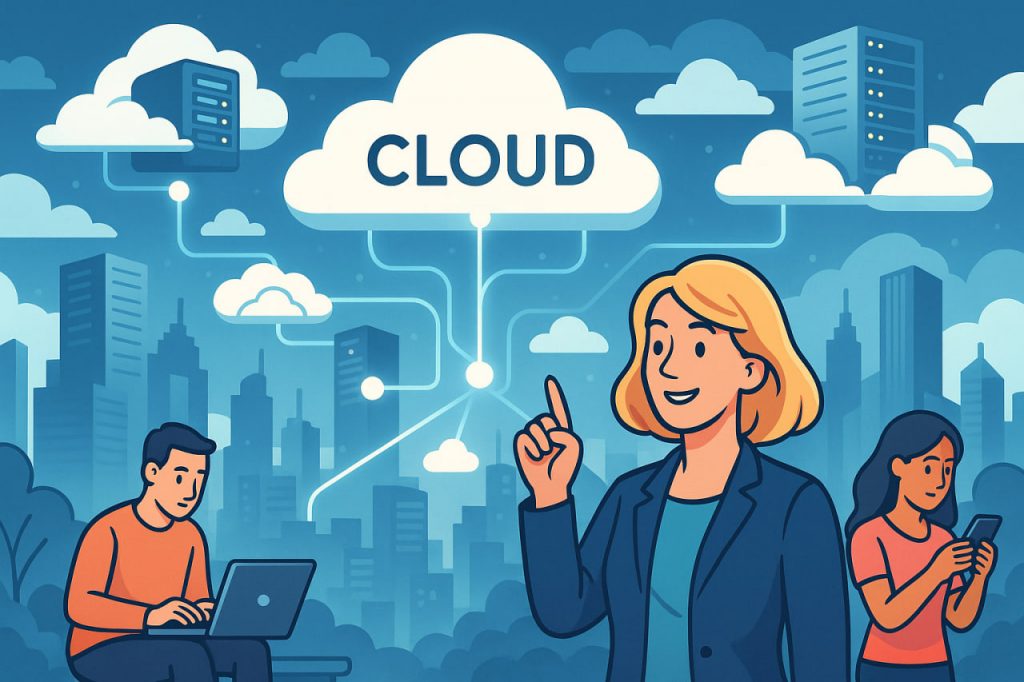The term “cloud” is one of the most commonly used words in modern technology, yet many people still wonder what it actually means. The cloud is not a mysterious place in the sky—it is a vast network of servers, data centers, and digital storage systems connected through the internet. In simple terms, the cloud allows users to store, access, and process data remotely instead of relying on local devices like hard drives or USBs. This invisible infrastructure powers everything from streaming services and mobile apps to artificial intelligence and online collaboration, making it one of the pillars of the digital era.
How the Cloud Works
At its core, the cloud functions through distributed computing, where tasks and data are spread across many interconnected servers around the world. When you upload a photo to Google Drive or save a document to Microsoft OneDrive, your data doesn’t sit on your personal computer—it’s stored on a remote server in a data center. These servers are managed by companies known as cloud service providers (CSPs), such as Amazon Web Services (AWS), Microsoft Azure, and Google Cloud. The system automatically determines which server will handle your request, ensuring speed, security, and reliability.
The Evolution of Cloud Technology
The concept of cloud computing originated in the 1960s, when computer scientists like J.C.R. Licklider imagined a global network of connected computers. However, the cloud as we know it today began to take shape in the 2000s with the rise of broadband internet and virtualization technologies. Amazon pioneered modern cloud services with AWS in 2006, allowing businesses to rent computing power instead of maintaining expensive hardware. Since then, the cloud has become essential to industries ranging from healthcare to finance, driving the digital transformation of society.
Types of Cloud Services
Cloud computing is typically divided into three main categories:
- Infrastructure as a Service (IaaS) – Provides virtual hardware resources such as servers and storage. (e.g., Amazon EC2, Google Compute Engine)
- Platform as a Service (PaaS) – Offers an environment for developers to build and test applications without managing servers. (e.g., Microsoft Azure, Heroku)
- Software as a Service (SaaS) – Delivers applications directly through the internet, such as Gmail, Zoom, or Dropbox.
Each layer provides different levels of control, flexibility, and management depending on the user’s needs. The combined effect allows both individuals and organizations to access computing resources instantly—scaling up or down as needed.
The Advantages of the Cloud
One of the greatest benefits of the cloud is accessibility. Users can retrieve data anytime and anywhere, as long as they have an internet connection. This flexibility has revolutionized remote work, online education, and entertainment. The cloud also offers cost efficiency, eliminating the need for physical servers and maintenance staff. Furthermore, it enhances collaboration, allowing multiple users to work on the same document or project in real time. On a global scale, cloud computing drives innovation by providing small startups with the same technological power once reserved for large corporations.
Risks and Challenges
Despite its advantages, cloud computing is not without risks. Data privacy and cybersecurity remain the biggest concerns. Because data is stored on external servers, users must trust service providers to protect sensitive information. High-profile breaches have exposed weaknesses in cloud infrastructure, prompting companies to invest heavily in encryption and multi-factor authentication. There is also the issue of data sovereignty, as the physical location of servers can determine which country’s laws apply to the stored data. Environmental impact is another growing concern—massive data centers consume enormous amounts of electricity and water for cooling.
Expert Perspectives
Technology experts agree that the future of computing will increasingly depend on the cloud. Satya Nadella, CEO of Microsoft, describes it as “the world’s computer”—a global brain powering artificial intelligence, data analytics, and automation. Meanwhile, cloud strategist Werner Vogels from Amazon emphasizes resilience and scalability, arguing that cloud services allow innovation at a pace never before possible. However, cybersecurity professionals like Bruce Schneier warn that dependency on centralized data systems could create new vulnerabilities if not managed with transparency and oversight.
The Future of the Cloud
The next stage of cloud evolution will likely involve edge computing and quantum cloud services. Edge computing brings processing power closer to the user, reducing latency for technologies like self-driving cars and smart cities. Quantum computing, still in its infancy, could revolutionize cloud performance by solving complex problems far faster than traditional systems. Experts also predict a growing emphasis on green cloud initiatives, using renewable energy and sustainable design to minimize environmental impact. As digital ecosystems expand, the cloud will continue to be the invisible backbone of modern civilization.
Interesting Facts
- Over 60% of global data is stored in the cloud today.
- The largest data centers can consume as much electricity as a medium-sized city.
- NASA uses cloud computing to analyze massive datasets from space missions.
- Streaming services like Netflix rely entirely on cloud infrastructure to deliver video worldwide.
- The term “cloud” originated from the network diagrams used in early telecommunications.
Glossary
- Distributed Computing – The practice of dividing computing tasks among multiple interconnected systems.
- Data Center – A facility containing servers and networking equipment used to store and process data.
- Virtualization – Technology that allows multiple operating systems to run on a single physical machine.
- Cloud Service Provider (CSP) – A company offering cloud computing infrastructure or software.
- Encryption – A method of protecting data by converting it into a secure code.
- Latency – The delay between a user’s request and the system’s response.
- Edge Computing – Processing data closer to the source to reduce latency and bandwidth use.
- Data Sovereignty – The concept that data is subject to the laws of the country in which it is stored.
- Quantum Computing – An advanced computing paradigm that uses quantum mechanics to process data.
- Green Cloud – Environmentally sustainable cloud computing powered by renewable energy.


